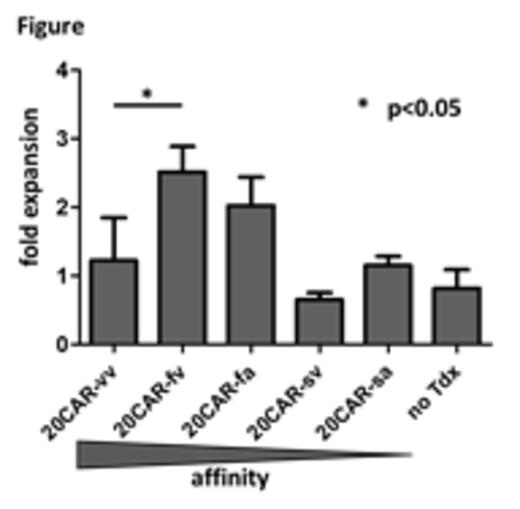Abstract
Background: Single-chain fragment variable region (scFv) in a chimeric antigen receptor (CAR) is a key component that directly binds the target antigen and transmits an activating signal into the CAR-T cells, subsequently triggering its effector function against the target cell. Thus, the affinity of scFv is considered to be critically important for CAR-T-cell function. However, optimal scFv affinity to induce maximal CAR function remains unclear.
Methods: In this study, we constructed anti-CD20 scFv based on the reported sequence of humanized anti-CD20 monoclonal antibody with five different affinities: 20-vv (Kd value=7.07 nM), -fv (7.21), -fa (10.09), -sv (12.56), and -sa (14.66). Each scFv was then fused to an IgG4 hinge, a CD3-zeta chain, a CD28 costimulatory domain, and a truncated version of the epidermal growth factor receptor (tEGFR) as a transduction and selection marker. CD8-positive T cells from a healthy donor were activated with anti-CD3/28 beads, transduced with the CARs on day 3, and enriched by selection with anti-EGFR mAb. CAR-T cells were expanded using anti-CD3/28 beads and used in the subsequent analysis.
Results: To determine the lytic activity according to the scFv affinity, we tested cytotoxicity against CD20-transduced K562 cells (K562-CD20) by 51Cr releasing assay. CAR-T cells with the three highest-affinity scFv (20CAR-vv, -fv, -fa) effectively and equally lysed K562-CD20, while CAR-T cells with the two lowest-affinity scFv (20CAR-sv, -sa) failed to exhibit significant cytotoxicity (20CAR-vv, -fv, -fa, -sv, and -sa: 60.2±2.85%, 57.3±2.03%, 57.0±3.82%, 2.8±0.1%, and 2.0±0.64% at an E:T ratio = 10:1, respectively). To examine CAR-T-cell activation, cytokine secretion in the supernatant after 16 hours of culture with K562-CD20 was analyzed. Similarly to the cytotoxicity, 20CAR-vv, -fv, and -fa produced cytokine, but 20CAR-sv and -sa did not. The highest-affinity CAR-T (20CAR-vv) produced significantly higher IFN-g and IL-2 than the other CAR-T cells [IFN-g (pg/ml): 7644±326, 3380±179, 4718±315, 4.9±0.4, and 5.4±1.2; IL-2 (pg/ml): 4179±177, 1071±30, 1379±118, 0, and 0, respectively]. We next analyzed cell proliferation upon stimulation with K562-CD20 over 72 hours. 20CAR-vv resulted in rather poor absolute cell proliferation, while CAR-T cells with the second and third highest-affinity scFv (20CAR-fv, -fa) resulted in preferable proliferation (1.22±0.20-, 2.52±0.12-, 2.01±0.42-, 0.65±0.11-, and 1.15±0.13-fold expansion, respectively). To explore the possible reason for the difference of CAR-T proliferation, we evaluated activation-induced cell death (AICD) at 24 hours after the K562-CD20 stimulation (Annexin-V/PI staining). 20CAR-vv underwent significantly higher AICD than the other CAR-T cells (68.4±1.1, 39.6±0.7, 37.9±5.3, 25.9±11.2, and 16.1±1.2% cell death). Finally, we tested cell proliferation and AICD of the three highest-affinity scFv CAR-T cells (-vv, -fv, and -fa) upon CD20 high and low stimulation. In this experiment, we used CD20-transduced CEM cells, which are controlled to express high and low CD20: CEM-CD20 high (CD20 = 143,000 molecules/cell, the same level as other B-cell lines) and CEM-CD20 low (5,320 molecules/cell, the same level as the rituximab refractory cell line). The replacement of the stimulator from CD20-CEM high to low resulted in partial reduction of AICD to a level comparable to those of other 20CARs (-vv, 62.7%→33.0%, -fv, 56.0%→37.4%, –fa, 55.3%→27.7%), but the cell proliferation upon stimulation did not improve (-vv, 1.2-, -fv, 2.6-, -fa, 2.7-fold expansion after CD20-CEM low stim). These results suggest that the higher-affinity scFv was not necessarily associated with better CAR-T proliferation after ligation and may inhibit cell proliferation, possibly by multiple factors besides AICD.
Conclusions: We observed that scFv with affinity above a certain level is needed to induce CAR-T function. Higher-affinity scFv induced more robust cytokine production; however, excessively high-affinity scFv in CAR can counteract T-cell proliferation, which may be partially associated with increased AICD. Optimization of scFv affinity is desirable for effective CAR-T production.
No relevant conflicts of interest to declare.
Author notes
Asterisk with author names denotes non-ASH members.


This feature is available to Subscribers Only
Sign In or Create an Account Close Modal